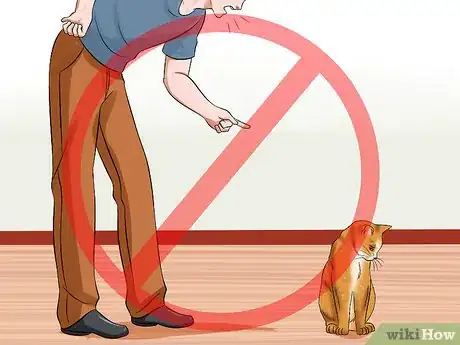This article was co-authored by Brian Bourquin, DVM. Brian Bourquin, better known as “Dr. B” to his clients, is a Veterinarian and the Owner of Boston Veterinary Clinic, a pet health care and veterinary clinic with three locations, South End/Bay Village, the Seaport, and Brookline, Massachusetts. Boston Veterinary Clinic specializes in primary veterinary care, including wellness and preventative care, sick and emergency care, soft-tissue surgery, dentistry. The clinic also provides specialty services in behavior, nutrition, and alternative pain management therapies using acupuncture, and therapeutic laser treatments. Boston Veterinary Clinic is an AAHA (American Animal Hospital Association) accredited hospital and Boston’s first Fear Free Certified Clinic. Brian has over 19 years of veterinary experience and earned his Doctor of Veterinary Medicine from Cornell University.
There are 8 references cited in this article, which can be found at the bottom of the page.
This article has been viewed 152,643 times.
Many people think getting a cat to listen to commands is impossible. This is not the case. While cats can be more challenging to train than dogs, with time and patience you can get a cat to listen to you better. To start, establish a rewards system. Find a way to make your cat understand when it is behaving well. Train your cat daily, in short sessions, so it understands appropriate behavior. Correct poor behavior in the moment, but do so gently. Punishing your cat will only succeed in stressing it out and may actually encourage poor behavior.
Steps
Establishing a Reward System
-
1Figure out what kind of food your cat loves. Treats can be a great way to reward your cat for positive behavior. However, the kind of treats matter. Your cat is unlikely to behave for everyday food. Find a treat it loves and use that as a reward.[1] [2]
- Buy a variety of treats at a local pet store and see what your cat likes. Try to use the treats it responds well to in training.
- You may also be able to feed your cat some table scraps. Some cats love things like turkey and chicken. If your cat has a particular fondness for a certain table food, that may work as a reward.
-
2Try other rewards. Not every cat responds well to food. Your cat may prefer another type of reward. Maybe your cat loves a particular toy. You could reward it by letting it play with that toy after it behaves. If your cat is particularly friendly, try petting as a reward.[3]Advertisement
-
3Establish a connection with rewards using a clicker. You can buy a small clicker at a pet store. You can use this as a way to let a cat know it is behaving well. Teach your cat to associate the clicker with positive experiences.[4]
- Choose a small, quiet place to work that is free of distractions. This will keep your cat focused.
- At first, all you need to do is establish a click means a reward is coming. Sit with your cat and press down on the clicker. Then, immediately give your cat a reward. You can give it a treat, a toy, or attention.
- Do this each day until you cat begins to perk up at the sound of the clicker. Cats are easily distracted, so keep training sessions short. Sessions should be no longer than 5 minutes.
-
4Start clicking when your cat listens to you. This will reinforce that listening is good. Your cat understands the clicker means a reward, so keep the clicker on you around the house. When your cat listens, press the clicker.[5]
- For example, you see your cat eating one of the plants in your house. You say something like, "Get down."
- If your cat gets down in response, press the clicker. If it does not get down in response, do not press the clicker.
Reinforcing Positive Behaviors
-
1Reward your cat in the immediate moment. Animals live in the immediate. Your cat will not understand what it is being rewarded for if rewards are delayed. The second your cat listens, give it a reward.[6]
- For example, your cat is pawing at another cat in your home. You tell it, "No" and it immediately leaves the cat alone.
- Do not wait a few minutes to reward it. Immediately click and offer a reward.
- If you're using treats as a reward, you may want to carry a few treats with you around the house. That way, if your cat listens, you can offer it a reward right away.
-
2Practice with your cat each day. This will help solidify behaviors. It will encourage your cat to listen to your more in day-to-day life. You can try teaching your cat small commands that encourage listening, like coming in response to his name.[7] [8]
- Choose an area free of distractions and keep sessions short. In general, less than 5 minute sessions are key. Cats have short attention spans.[9]
- Instruct your cat to engage in a certain behavior. Reward it when it does that behavior. For example, call your cat's name. If it comes to you, give it a reward.
- You usually have to work increments. This means, settling for your cat partially completing the behavior first. For example, you tell your cat to come and it takes a few steps forward. Give it a reward. With time, demand more from it. Do not reward it until it completes more of the behavior.
-
3Reprimand your cat gently. Cats should not be yelled at for bad behaviors, but there should be some consequences. If you want your cat to listen, make sure it understands what "No" means.
- You do not need more than a loud, "No" when your cat misbehaves. Avoid screaming, as this can upset your cat. Simply say, "No" when it engages in a negative behavior.
- If your cat stops the behavior when you ask, reward it with treats, a toy, or praise.
- If your cat does not listen when you say "No," try adding a small clap as well.
-
4Cut down on treats and rewards with time. You want your cat to eventually behave without a reward. You do not want to teach your cat it should only behave well when there's something in it for it. As your cat listens to you more and more, taper off rewards.[10]
- Make use of the clicker. Your cat will eventually learn to see this as a reward in and of itself, as it indicates it is behaving properly.
- Once your cat seems to have mastered listening to you, only reward it every other time it behaves. With time, wean it off rewards altogether.
Avoiding Negative Training Tactics
-
1Do not use a squirt bottle. Many advocate keeping a squirt bottle filled with tap water on hand. If a cat misbehaves, they will give it a quick squirt as punishment. This will not teach your cat proper behavior. In fact, it can actually make negative behaviors worse.[11]
- Squirting a cat with a water bottle just creates stress. Oftentimes, a cat is engaging in a negative behavior because something is wrong.
- Your cat may, say, scratching furniture because it dislikes his scratching post. Punishing it for scratching furniture will not stop your cat from doing it. It will only learn to scratch when you're not around.
- A squirt bottle will make troublesome behaviors worse. If your cat feels stressed in his home, it may become more aggressive and act out more frequently.
-
2Avoid "scruffing." This means grabbing the loose skin of a cat's neck to stop negative behaviors. Many people believe scruffing will assert dominance over a cat. However, scruffing frightens and humiliates adult cats. It will not improve a cat's behavior.[12]
- The only situation in which scruffing is appropriate is a medical emergency. For example, if your cat is hurt you will need to get it to the vet. If your cat is upset and resisting going into his crate, scruffing may be the only way to stop its squirming.
- If you do scruff your cat due to an emergency, release your grip as soon as the danger has passed.
-
3
Expert Q&A
Did you know you can get expert answers for this article?
Unlock expert answers by supporting wikiHow
-
QuestionIs it possible to train cats?
 Brian Bourquin, DVMBrian Bourquin, better known as “Dr. B” to his clients, is a Veterinarian and the Owner of Boston Veterinary Clinic, a pet health care and veterinary clinic with three locations, South End/Bay Village, the Seaport, and Brookline, Massachusetts. Boston Veterinary Clinic specializes in primary veterinary care, including wellness and preventative care, sick and emergency care, soft-tissue surgery, dentistry. The clinic also provides specialty services in behavior, nutrition, and alternative pain management therapies using acupuncture, and therapeutic laser treatments. Boston Veterinary Clinic is an AAHA (American Animal Hospital Association) accredited hospital and Boston’s first Fear Free Certified Clinic. Brian has over 19 years of veterinary experience and earned his Doctor of Veterinary Medicine from Cornell University.
Brian Bourquin, DVMBrian Bourquin, better known as “Dr. B” to his clients, is a Veterinarian and the Owner of Boston Veterinary Clinic, a pet health care and veterinary clinic with three locations, South End/Bay Village, the Seaport, and Brookline, Massachusetts. Boston Veterinary Clinic specializes in primary veterinary care, including wellness and preventative care, sick and emergency care, soft-tissue surgery, dentistry. The clinic also provides specialty services in behavior, nutrition, and alternative pain management therapies using acupuncture, and therapeutic laser treatments. Boston Veterinary Clinic is an AAHA (American Animal Hospital Association) accredited hospital and Boston’s first Fear Free Certified Clinic. Brian has over 19 years of veterinary experience and earned his Doctor of Veterinary Medicine from Cornell University.
Veterinarian Yes, just like dogs, cats can be trained. The key to training a cat is positive reinforcement. Reward your cat with treats, petting, toys, or whatever it likes when it does something right to reinforce the good behavior. Avoid punishing your cat when it does something wrong since cats don't respond to punishment and it can actually make them less trusting of you.
Yes, just like dogs, cats can be trained. The key to training a cat is positive reinforcement. Reward your cat with treats, petting, toys, or whatever it likes when it does something right to reinforce the good behavior. Avoid punishing your cat when it does something wrong since cats don't respond to punishment and it can actually make them less trusting of you.
Warnings
- Avoid using milk or dairy products as a reward. Cats actually do not do well with milk. They cannot digest dairy properly. It can cause vomiting diarrhea.[15]⧼thumbs_response⧽
References
- ↑ http://pets.webmd.com/cats/guide/kitten-training-tips
- ↑ https://www.petfinder.com/cats/cat-behavior-and-training/how-to-teach-a-cat-tricks/
- ↑ Brian Bourquin, DVM. Veterinarian. Expert Interview. 20 December 2019.
- ↑ http://www.vetstreet.com/dr-marty-becker/3-tricks-to-teach-your-cat-with-a-clicker
- ↑ http://pets.webmd.com/cats/guide/kitten-training-tips?page=2
- ↑ https://www.petfinder.com/cats/cat-behavior-and-training/how-to-teach-a-cat-tricks/
- ↑ https://www.petfinder.com/cats/cat-behavior-and-training/how-to-teach-a-cat-tricks/
- ↑ http://pets.webmd.com/cats/guide/kitten-training-tips?page=2
- ↑ Brian Bourquin, DVM. Veterinarian. Expert Interview. 20 December 2019.
- ↑ https://www.petfinder.com/cats/cat-behavior-and-training/how-to-teach-a-cat-tricks/
- ↑ http://www.catbehaviorassociates.com/the-squirt-bottle-controversy/
- ↑ http://www.catbegood.com/cat-behavior/the-basics-of-cat-training/
- ↑ Brian Bourquin, DVM. Veterinarian. Expert Interview. 20 December 2019.
- ↑ http://pets.webmd.com/cats/guide/kitten-training-tips?page=2
- ↑ http://pets.webmd.com/cats/guide/cats-and-dairy-get-the-facts
About This Article
To train your cat to listen to your commands, start by finding a reward that it likes, such as a cat treat or a toy it likes to play with. Whenever your cat obeys your commands, give it the reward immediately so it’s clear which behavior you’re rewarding. Try to practice this for 5 minutes every day so the command sinks in. Once your cat learns to obey your commands, gradually cut down on its treats and rewards over time, so it behaves without needing an incentive. If your cat misbehaves, avoid punishing it, since this will only stress it out more. Instead, just say, “No,” and move it away from the area if you need to. For more tips from our Veterinary co-author, including how to use a clicker to train your cat, read on!





































































